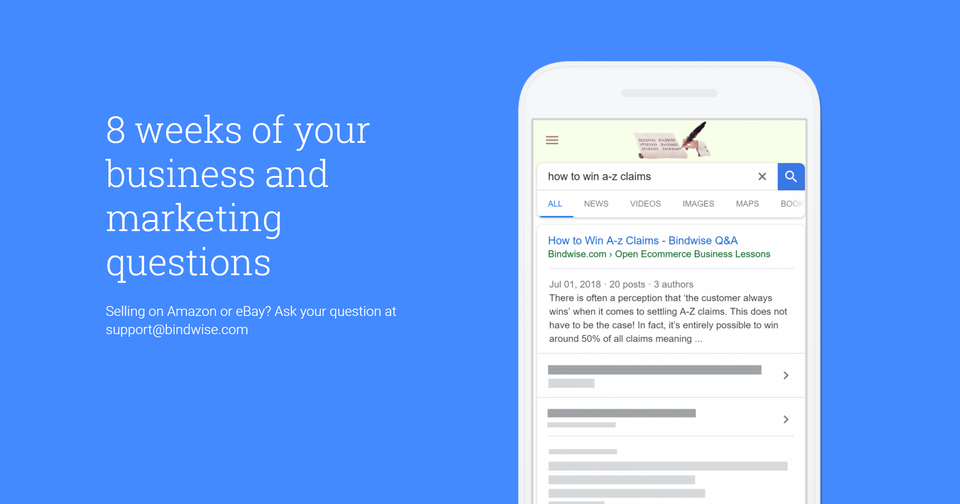Your Amazon Business & Marketing Q&A #2

Welcome to the second edition of ‘Your Amazon Business & Marketing Questions & Answers.’ For the next couple of weeks, this is going to be a bi-weekly Q&A series where we answer questions from our Amazon sellers. If you have any specific biz question don't hesitate to write us at [email protected].
In this post we're going to answer:
- Is it possible to see what keyword lead to purchase without PPC?
- Why do I experiencing a dramatic drop in sales?
- Is it ok to drive outside traffic onto an Amazon listing?
- Can a manufacturer enforce MAP on Amazon?
- Why does Amazon hate its sellers?
Is it possible to see what keyword lead to purchase without PPC?
Sadly, not. But there is a lifehack. What you can do though is run a keyword testing campaign like this...
Example product: Stainless Steel Garlic Press
-
So run in all three (broad, phrase, exact): stainless, professional, easy to clean, steel, garlic press.
-
Then run $150 worth at a high bid, say $3/click to make sure you're getting all possible outcomes shown.
-
Then drop the bid to $1.5 and let it run, then $0.5 and let it run.
-
Then generate a report. It will show you the highest volume (impressions) for customer search terms, and what people are clicking on that's converting. From there you can optimize to make it profitable.
Bottom line. It's an expensive method, it's not profitable, BUT you will find that this method is 10x better for keyword research and harvesting than just running an auto campaign. Bear in mind, that it's still a good idea always run a lower bid auto campaign in the background to show up for "sponsored products related to" sections.
Why do I experiencing a dramatic drop in sales?
Make sure you’re conducting a complete check of your entire inventory. Not just a cursory check in your inventory list, but clicking through to each and every listing to make certain it’s live. You can monitor whether you listing is live by setting up automatic alerts which notifies you the moment your listing is down.
Over the past couple of weeks we heart many similar stories about “bad” ASINS and people finding “dog” pages when they try to click through to their listings (dog page being the Amazon equivalent of your suspended listing).
Here's a catch. The inventory list shows the listing as active, there are no suppressed listings, in other words everything looks normal. You only know something is wrong if:
- you try to click through to the actual catalog page, or
- receive an automatic alert about your listing from Bindwise.
How many of you actually click through to your catalog pages on a regular basis? Maybe few of you, but if your inventory list shows everything as “active” and you’ve got the Buy Box, you just move on.
So what's the cause? Many impacted users have been round and round with Amazon Seller Support and it appears to be catalog update or ASIN issues, or brand registry errors on the Amazon side. Amazon Seller Support keeps assuring people they’re fixing the problem, but permanent fixes seem to be fleeting. Some users are reporting hundreds of their listings returning the "dogs" pages.
Bottom line. So, if you’ve been experiencing your sales tanking without any obvious cause, you might want to manually check all your listings or setup an automatic notifications. This may not be what’s causing your problems, but it could be the culprit.
Is it ok to drive outside traffic onto an Amazon listing?
Absolutely. Make sure you become an affiliate though so you can get commissions on those links. Not only do you get commission if they purchase your item, it dumps a 14 day cookie and you get commission on ANY products they purchase on Amazon over 14 days. https://affiliate-program.amazon.com/. Bear in mind to not make any false claims when sending traffic to Amazon.
Can a manufacturer enforce MAP on Amazon?
To make a long story short. Amazon will not enforce MAP for them.
Use case. Imagine this odd situation that you haven't run into before. You buy a sports product directly from the manufacturer to sell on Amazon (let's say you verbally told them that you multichannel and sell via various marketplaces). At no point was there any discussion or paperwork signed that mentioned minimum pricing.
A week into selling, the manufacturer contacts you via Amazon and asks you to change your price to their minimum or they will have you banned from the listing.
First assumptions are that:
-
They can't get you kicked off of an Amazon listing for violating MAP.
-
However, they can obviously just stop selling to you.
So the question is that correct, or is there any action that they can take without any signed agreements on your part?
Answer. Amazon will not enforce MAP for them. They rarely adhere to MAP themselves. The manufacturer can simply stop selling to you.
A lot of them will use shady tactics though and claim to Amazon things like trademark infringement or counterfeit. That's what you have to watch out for. Otherwise, they can't do anything to you for selling under MAP other than to not sell to you again.
The easiest way to correct this issue is to add a strike through pricing where MAP is the strike through and you have to add to cart to see the actual price. Amazon will award you the Buy Box and put the strike through up if you are the best price.
Bottom line. If you want to stay friends with the manufacturer, sell at MAP and compete with everyone else.
Why does Amazon hate its sellers?
So the word ‘HATE’ may be harsh, but why are they so unfair to sellers? Don't you have any rights as sellers?
Amazon does not hate its third party sellers. However, as rude as it might sound, you are highly dispensable. As a result, they know that if you leaving the platform there are probably several other new sellers that will take your place.
Buyers on the other hand are not. Customer loyalty becomes very valuable. It’s far more important that customers remain happy.
Additionally, you have rights, but when you do not adhere to policy nor follow the rules, you cannot complain about Amazon not treating sellers fairly.
A seller, regardless of being on ‘vacation’ or not, are required to respond to messages within 24 hours. When a claim is filed, a seller has 3 days to provide a response to it. Failure to respond to a claim, even if Amazon agreed with you, they are forced to follow policy and find for the buyer.




